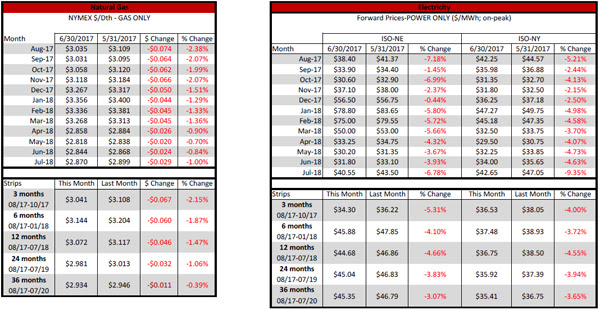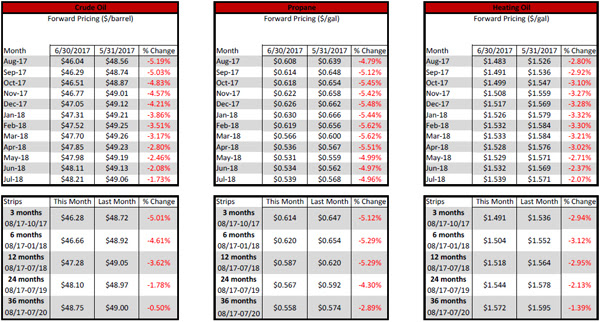July 2017 Energy Report
This email contains the month over month comparison of energy prices as well as the monthly commodity settlement prices. If you have any questions about your energy and waste portfolio or for an invoice and energy audits, price quotes for natural gas, electricity or waste, please contact RJ Consulting today.
Natural Gas
Natural gas prices found price resistance and were able to set a 4 month low for the July 2017 contract at $3.067/Dth, down $0.169/Dth from the June 2017 contract. The month of June produced an interesting trading range for the July contract. The July contract hit a high of $3.145/Dth and a low of $2.893/Dth. Reports indicated this was mainly due to much cooler temperatures for the end of June and into the beginning of July which kept natural gas electricity demand down. For the first time since March 2017, we finally have the 3 year NYMEX natural gas average trading below $3.00/Dth. We have plenty of drilling activity with the rig count ending the month of June 2017 at 184 natural gas rigs which are a 107% increase over last year’s number of 89 rigs. It looks like natural gas prices will increase over the next few months based on how hot and how long the summer weather holds on for. If the natural gas market reacts to summer temperatures, we should see the August 2017 contract settle between $3.12/Dth to $3.28/Dth.
Electricity
As noted above, electricity prices closely follow natural gas prices due to over 50% of electricity produced in the US coming from natural gas. Fuel used to generate power is a major percentage of the total cost of the generation rate but not the only cost. Electricity needs to be distributed on transmission lines to the utility company, cover capacity and ancillary charges, as well as any line loss and renewable energy requirements. Over the next few years, the capacity cost will be much more expensive than previous years. The capacity price is set until 2020, and the only impact your business will have at this price is the change to your capacity tag. The capacity tag is usually set on the hottest day of the year. This tag is used to understand the potential peak demand our electricity demand has on the system and to ensure we have enough power. The capacity price is set, but the capacity tag changes yearly. With summer right around the corner and looking for ways to reduce electricity cost, setting a lower capacity tag will help. This can get confusing, so if you have questions about power, pricing or to review peak demand or the capacity tag, please call RJ Consulting today!
Please contact RJ Consulting if you would like to review your energy and waste portfolio. If you have any feedback or suggestions to the monthly emails, please share!
July 2017 Energy Report



![]()
If you have any questions or concerns about your current energy portfolio, please call or email to discuss.
Sincerely,
Roman Katynski, CEP
Energy & Waste Consultant, Owner
RJ Consulting LLC
An Energy and Waste Consulting Company
